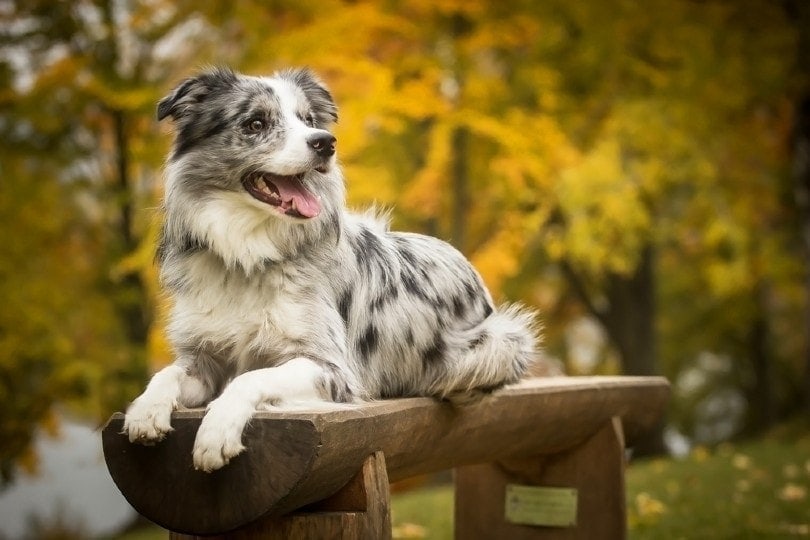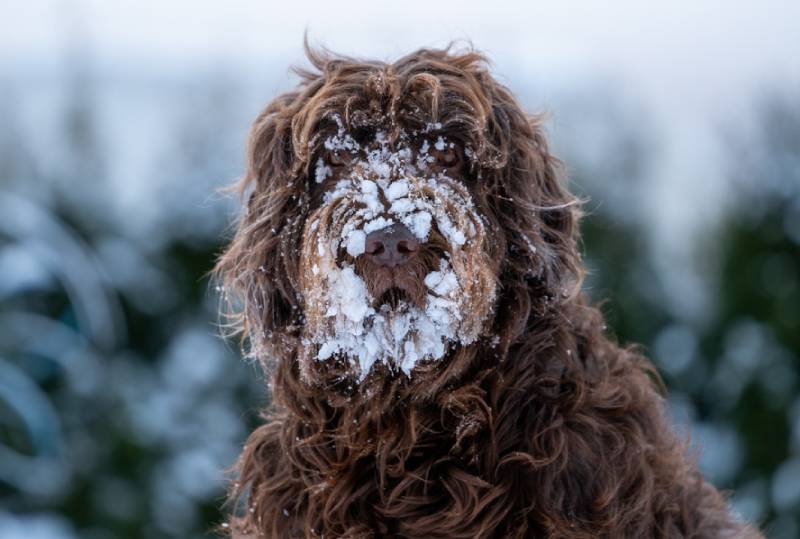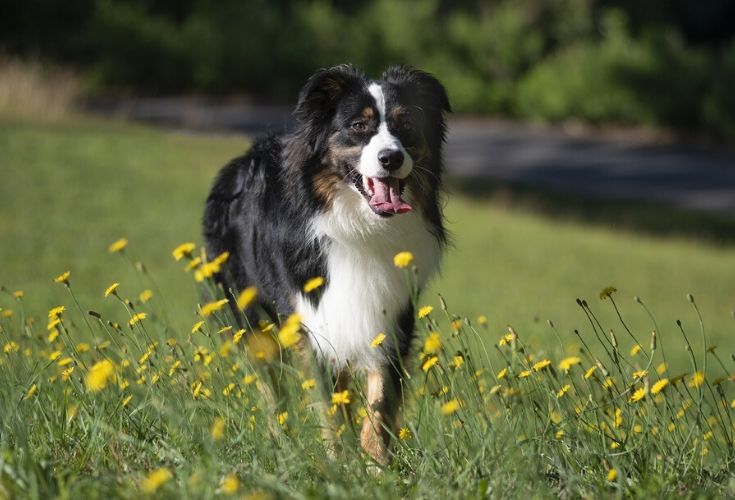Shar Pei Mastiff Mix: Pictures, Care Guide, Temperament & Traits

Updated on
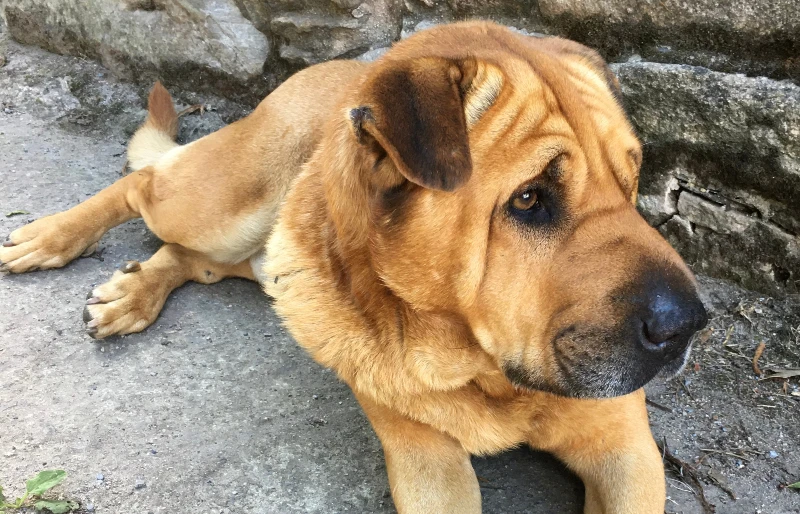
Mastiffs have been around for thousands of years, praised for their unwavering loyalty, protective nature, and intelligence. The Chinese Shar-Pei dogs are just as strong, faithful, and capable guardians. And when these two ancient breeds are mixed, you get an imposing yet affectionate pet. The Shar-Pei Mastiff is a multi-talented, majestic dog, perfect for experienced owners looking for a dignified protector for their property.
| Height: | 20–28 inches |
| Weight: | 50–180 pounds |
| Lifespan: | 6–12 years |
| Colors: | Black, cream, brown, red, fawn, brindle, apricot |
| Suitable for: | Experienced owners with adult kids |
| Temperament: | Protective, faithful, affectionate, aloof with strangers, stubborn |
The Mastiff Shar Pei is a big, strong, and tenacious dog with a brilliant mind and loving heart. Due to its formidable size and independent nature, it’s not recommended for first-time owners. This dog creates strong bonds with its human family, yet it doesn’t take kindly to strangers and can be extremely aggressive and territorial. So, how do you train and socialize a Shar-Pei Mastiff mix? How much exercise does it need? Is the pup safe around children? Read on to find out!
Shar Pei Mastiff Mix Characteristics
Shar Pei Mastiff Mix Puppies
The Mastiff Shar-Pei is an extremely rare hybrid. It’s fairly common for Bulldogs, Pitbulls, Terriers, and Boxers to be bred with Mastiffs to create the “best of both worlds”. Other dogs that are often mixed with Mastiffs include Burmese, Retrievers, and Bulldogs. However, a lovechild between an English Mastiff and a Chinese Shar Pei is not at all common. That’s why you’ll have a hard time trying to buy it at a pet store or from a professional breeder.
Luckily, rescue centers and animal shelters don’t discriminate between purebred and crossbred puppies. So, you might have better luck looking for a Shar-Pei Mastiff there. Call or email ahead, though, as you’ll probably need to check a couple of shelters before hitting the jackpot. Another thing to keep in mind: these dogs grow quickly and need to be trained as soon as you bring them home. They’re quite the guzzlers, too!
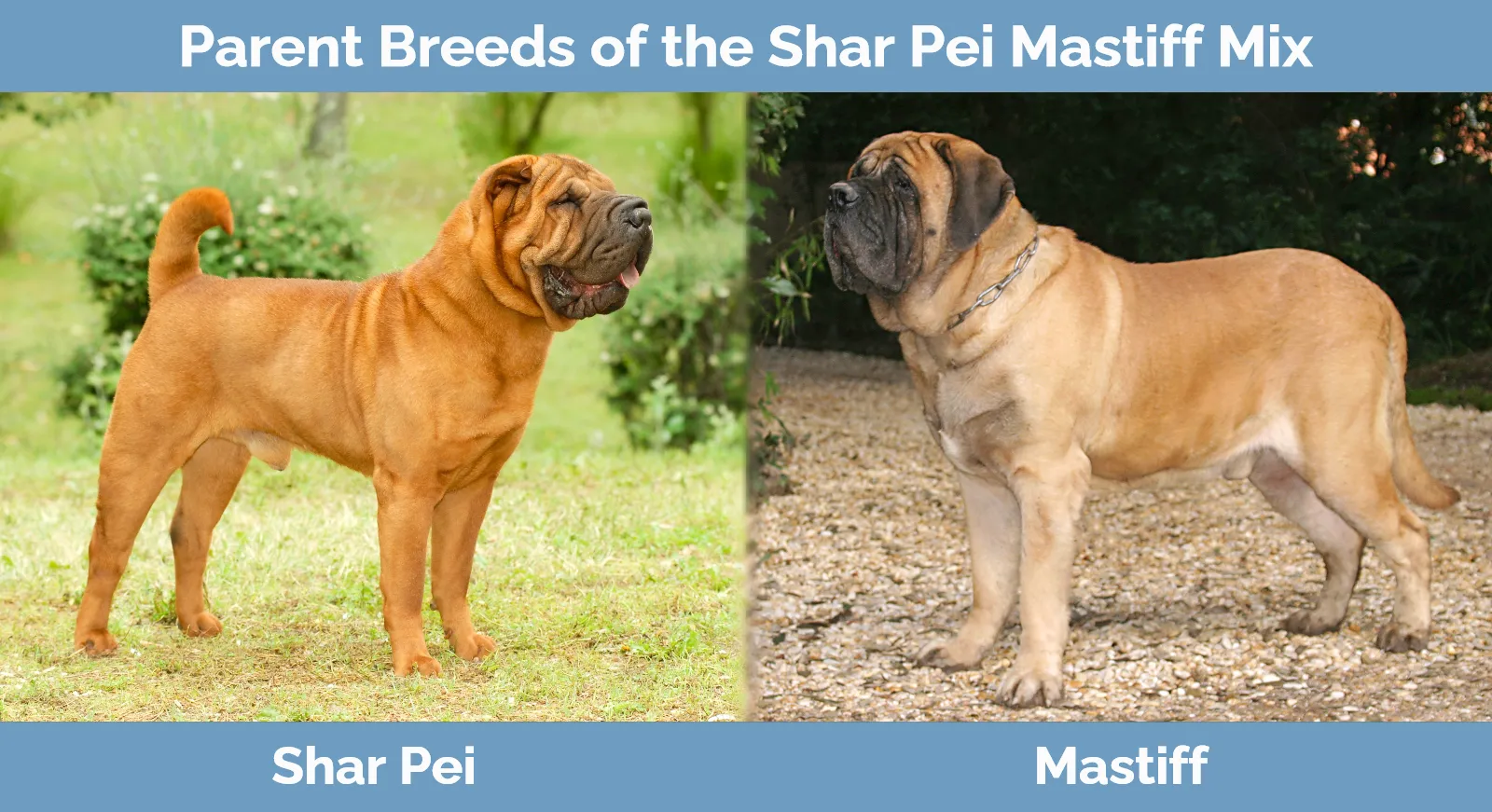
Temperament & Intelligence of the Shar Pei Mastiff Mix
Dogs with big, witty minds and a fearless nature tend to have that “I-know-better” kind of attitude. That’s exactly what the Shar-Pei Mastiff breed is like. Even as pups, these buds have a strong will and don’t rely on their human parents much. And this has a lot to do with their upbringing. Many centuries ago, Mastiffs were bred to serve as guard dogs, keeping burglars and beasts away. Mastiffs were also used as hunting buddies and even war dogs.
Shar-Peis are just as good at guarding livestock on large properties. But what about the temperament/behavioral patterns? Alert, smart, and protective: that’s the best way to describe it. Also, this might come as a surprise, but the Mastiff Shar-Pei is not at all noisy. It’s a tranquil, mind-my-own-business type of pet that prefers to conserve its energy for when it’s really needed.
Are These Dogs Good for Families? 👪
For the most part, that depends on the owners. This hybrid doesn’t make a great starter pet, as it needs quite a lot of training and socialization to behave around strangers. Furthermore, it’s a big beast, and that can also be a challenge. On the other hand, people who know how to interact with a headstrong giant will find it to be a near-perfect dog. Just like its parent breeds, the Shar-Pei Mastiff is a curious, determined, joyful, and affectionate dog.
It’s not at all clingy yet likes to play, exercise, and chill with its favorite humans, strengthening the bond. And you don’t have to be very active to keep the pet happy because its exercise needs are rather low. Another big pro: this four-legged friend doesn’t mind living in a relatively small apartment as long as you take it out for a short daily walk or jog.
What About Young Children?
Mastiffs are recognized as one of the largest dogs to walk the Earth. Shar-Pei isn’t nearly as big, but it’s still strong and heavy (up to 60 pounds). As for the mixed breed, it often reaches around 150 in weight, which is why it’s not a good pet to have around kids. Now, this dog is very fond of humans of all ages, including children. The problem is that when left alone with overly noisy kids, it might lose its patience.
Children often treat pets (no matter how big) as toys and like to play with their fur, pull their ears, and touch them in all the wrong places. Those areas include the paws, the top of their heads, and the tail. And let’s not forget about accidents. A large animal like the Shar-Pei Mastiff can easily hurt a child without even realizing it. So, only allow kids to play with this dog if you’re there to provide supervision.
Does This Breed Get Along With Other Pets?
Protective dogs aren’t very friendly toward strangers. And, since both Shar-Pei and Mastiff dogs have been on guard duty for countless generations, they’re naturally aloof with strangers. This is often true for fellow canines, but felines, rodents, and other small family pets might get the “pass”. This can be achieved if you raise them together while the guardian is still a puppy.
That said, if your cat is a bit too curious and likes to zoom around the room, that could (potentially) trigger the dog’s hunting instincts. While Shar-Peis have a very strong prey drive and tend to terrorize smaller mammals, Mastiffs aren’t nearly as willing (or capable) to chase a cat. So, yes, this mostly depends on which parent breed the pup takes after.
Things to Know When Owning a Shar Pei Mastiff Mix:
Food & Diet Requirements 🦴
Mastiff pups grow rapidly and require large-breed food for proper development. That said, a high-calorie diet with the wrong phosphorus/calcium ratio often leads to various bone disorders. Veterinarians recommend sticking to a 1.2:1 ratio for the best results. And when the pup turns into an adult, see that it gets enough protein (no more than 26%). Next, free feeding is not the best choice here; instead, create a schedule and stick to it.
This way, you can keep the pet well-fed and avoid obesity. Premium-quality food with healthy fats, no filler ingredients, and a small percentage of veggies and grains is the way to go with the Shar-Pei Mastiff hybrid. Animal fats should be avoided, though, just like low-quality grains (think soy). Lastly, resist the urge to let the dog eat leftovers from your table, as that won’t do the pet any good.
Exercise 🐕
Compared to Shepherds or Labradors, Shar-Pei Mastiffs don’t need nearly as much exercise. A relatively short walk or jog around the block (for 1–2 miles) and some low-activity games should be enough to keep the pet content. And if it’s a puppy (two or three months old), make the walks even shorter. Forcing this dog to run or jump up and down will put unnecessary pressure on its joints.
However, if it gets most of its energetic genes from the Chinese parent, the pet will need a bit more exercise to stay in shape. Most Shar-Pei dogs love agility, tracking, and other high-intensity games. Talk to a veterinarian to come up with the perfect routine for it. And remember to go slowly and let the dog enjoy your time together outside instead of wearing it out.
Training 🎾
You won’t go far with a Shar-Pei Mastiff without socialization and obedience training. So, start as early as you can to shape the pup into an even-tempered, friendly adult. These dogs are very intelligent and don’t take long to learn. On the downside, the attention span of the parent breeds is very short. Therefore, keep the training sessions short yet exciting. On average, 2–3 sessions per day should be fine.
Another pro tip: always look the pet in the eyes and use body language to encourage it for another round of training. Get the dog to trust you via positive reinforcement and patience. Despite the gigantic size, the Mastiff Shar-Pei has a sweet, fragile heart and gets offended easily. So, no scolding, yelling at the dog, or punishing it for not following commands! Be a firm, yet respectful leader to become the dog’s boss and best friend.
Grooming ✂️
Both Mastiffs and Shar-Pei require moderate grooming. For starters, brush the coat once or twice a week and bathe the dog every 3–4 weeks. During the shedding season, daily brushing might be in order. The nails, in turn, need to be clipped at least twice a month, while the ears should be cleaned weekly to avoid moisture buildup and bacteria growth. Ear-cleaning solutions are the best option here. Don’t use any peroxide or dog-specific cotton swabs, though.
The same care routine should be provided for the pup’s deep wrinkles. Oh, and don’t forget to buy as many towels as you can to deal with the drooling!
Health and Conditions 🏥
Premium-quality food, proper grooming, and frequent veterinary visits will help keep the Mastiff Shar-Pei in tip-top shape. With that, please remember that this hybrid has a relatively short lifespan (6–12 years, depending on which parent it takes after). Furthermore, as a heavy dog, it’s prone to dysplasia, GDV, and various allergies and infections. Here’s a quick look at the most common medical conditions in Shar-Pei Mastiff dogs:
- Ear infections
- Skin fold dermatitis
- Pododermatitis
- Hip dysplasia
- Degenerative myelopathy
- GDV
- Renal amyloidosis
- Entropion
- Retinal atrophy
- Epileptic seizures
Male vs Female
The males are larger and leaner compared to the females. The max weight for a male Mastiff is 230 pounds, while the females rarely go over 170 pounds. The height difference is present as well: 27 versus 30 inches. The same goes for the Shar-Pei dogs. Males are also more aggressive, territorial, and standoffish with strangers (this can be another dog, a different animal/pet, or a human).
And if you catch the pup mounting your favorite pillow or scent-marking the couch, best believe it’s a boy! A stubborn, headstrong nature will be a part of the deal as well. These sex-specific behaviors turn male Shar-Pei Mastiffs into exemplary guardians and watchdogs. Females are more peaceful, eager to please, and happy to follow commands. That makes them better first-time pets.
3 Little-Known Facts About the Shar Pei Mastiff Mix
1. The Shar Pei Mastiff Mix Can Have a Blue Tongue
This dog is already quite extraordinary, but, if it takes after its Asian mom or dad, you’ll get yourself a pet with a blue/black tongue. There’s a common myth that only the Chow-Chow dogs are born with such a tongue, but the Shar-Pei have it as well. Both breeds originated in China, and back in the day, it was believed that the black tongue helped Shar-Peis fend off wicked spirits.
2. These Dogs Are Intelligent and Quick to Adapt
Just like most cats, hamsters, and parrots, pups are creatures of habit. That means they like to stick to a familiar routine and don’t appreciate big changes. Thankfully, that’s not the case with the Mastiff Shar Pei. This is a smart, capable, and independent dog that doesn’t mind a change of scenery now and then and won’t develop destructive behavior or fall into stress/anxiety.
True, the Shar Pei Mastiff does have a stubborn streak, but, if you create a strong bond and the pet experiences early socialization, it will happily follow you to a new destination. The same goes for a big change in its daily schedule (like when you go to work, when the pet gets to have fun and even the feeding routine).
3. They Also Tend to Drool Quite a Lot
If you hate it when your dog turns an expensive comfy bed or carpet into a drooly mess, you’ll have to be extra vigilant with the Shar Pei Mastiff mixed breed. The folded lips, large jowls, and specific mouth structure turn these dogs into “drooling machines”. They simply can’t “handle” the amount of saliva their bodies produce. It’s important to note that both breeds—Mastiffs and Shar-Pei—are big, heavy, and have wrinkled faces.
So, it doesn’t matter much which parent the hybrid takes after: it will always have a slobbery mouth. And the more excited the dog gets, the more drool you’ll have to deal with. The mess might be even bigger when the pup gets excited (like about a tasty meal), nervous (strangers in the area), or when you take it for a ride (due to motion sickness). So, spread out the meals, stock up on towels and vinegar, and consider getting a bib/bandana for the dog.
Final Thoughts
The Shar-Pei Mastiff is a fearless warrior and a capable protector. With this dog keeping watch, you can rest assured no intruder will ever get through. More good news: despite the imposing size, this gentle giant loves nothing more than to spend quality time with its human parents. You should never let little kids interact with it, though, as the pet might accidentally hurt the children. This hybrid dog can be patient, but it doesn’t like to be bothered much.
More importantly, if you don’t put effort into training and socialization, the Mastiff Shar-Pei pup will grow into a headstrong, self-willed, and aggressive canine with little to no tolerance toward strangers. Yes, this mixed breed can be a handful, especially for a first-time owner. That’s why it’s only recommended for experienced pet parents with adult kids. This dog eats a lot, drools like there’s no tomorrow, and needs constant supervision. But in the right hands, it’s a marvelous pet!
See also:
- Box-a-Shar (Boxer & Shar Pei Mix): Info, Pictures, Characteristics & Facts
- Australian Shepherd Shar-Pei Mix: Pictures, Care Guide, Temperament & Traits
Featured Image Credit: Carlota Prats, Shutterstock



